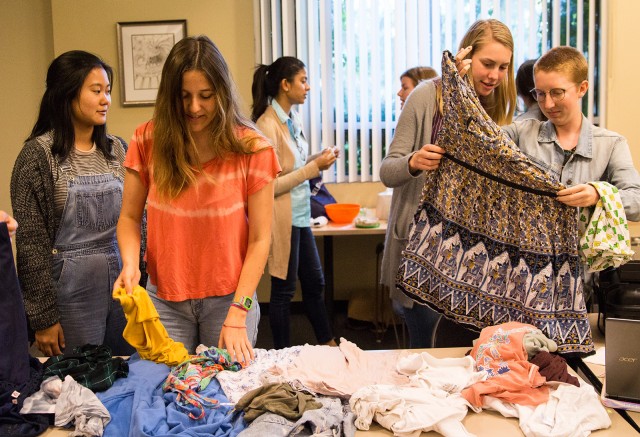The word “pollution” tends to evoke images of devastating oil spills in vast oceans or black fumes spilling from big, industrial factories.
Interestingly, the tremendous environmental implications behind the trendy clothes that hang in our own closets seem to constantly slip our minds.
With the recent completion of discount shopping blowouts like Black Friday and Cyber Monday, flashy price deals and new fashion trends continue to dominate the consumer market. And amid these ever-changing fashion vogues, the general public tends to overlook the driving force behind the booming fashion industry – its multiplicity and ability to quickly and easily mass distribute. This is fast fashion.
According to the Independent, fast fashion is an innovative means of fashion production that concentrates on cutting the time and cost it takes to produce frequent new collections inspired by catwalk looks or celebrity styles, often at the expense of environmental preservation and safety. Familiar brands such as H&M, Zara and Forever 21 often use this method of production.
Producers of fast fashion use pesticides and fertilizers, as well as emit high levels of carbon dioxide, ultimately leading to heightened pollution levels of our air, farmland and water.
According to the World Resources Institute, cotton, the most common natural fiber used to make clothing, accounts for about 33 percent of all textile fibers. Cotton clothing production does not only contribute to scarcity in areas facing water stress, but also accounts for 24 percent of insecticides and 11 percent of pesticides, even though it uses just 3 percent of the world’s arable land.
From start to finish, the process of clothing production places an extreme burden on the natural environment. The process starts with intense raw material extraction for cotton textiles, proceeds to contaminate drinking water and soil through factory production and ends with the discard of major textile waste that ultimately pollutes and contributes to climate change.
When we look at the life span of products, styles are much more short-lived today. People wear items for a shorter period of time, and the end of the life cycle of these pieces often means overstock and unused items are burned, releasing toxic chemicals into the atmosphere.
Consumers can work to combat this cycle, however.
Isabel Schulte, a second-year chemical engineering student and president of Unravel at UCLA, an organization that responds to this environmental harm primarily through education, said clothes have the biggest negative impact during their use cycle, which is where consumer choices can make the biggest difference.
“Making a small change has large implications in that thrifting reduces textile waste by reselling clothing, and therefore lowers the need for new clothing production,” Schulte said.
With the emergence of secondhand clothing stores and thrift shops, buying pre-owned fashion has slowly been introducing itself as an economical and enjoyable way to add personal taste to your wardrobe, all while taking care of the environment.
Hannah Sullivan, a second-year global studies and communication student founded TAKE OUT Clothing, which responds to the pressing environmental implications of the fashion industry by using mostly thrifted fabric and materials to create new looks, while using as little new material as possible. Additionally, TAKE OUT items are produced by hand rather than in a large, polluting factory.
“When you choose to shop at thrift stores, you are contributing to the recycling of clothing items that are already in existence,” Sullivan said. “Instead of allowing clothing to be thrown to landfills or burned into the atmosphere, you are giving new life to an old item.”
Thrifting has undoubtedly grown more mainstream. This rise into the limelight has even stimulated the “re-commerce” industry, as evident in the booming popularity of clothing resale websites and apps such as Depop and Poshmark.
Despite this wave of popularity, in an economy where price is equated with value a cheap product is usually associated with being lower-quality or is tagged as a “charity case.”
Schulte said she sees stigma associated with thrifting, but believes it is primarily tied to a choice. While thrifting by choice can be trendy and fashionable, Schulte said the stigma arises when someone is thrifting out of necessity because buying fast fashion is out of their financial means.
“Unfortunately, thrifting is inherently tied to class stigma and discrimination, so the stigma attached to secondhand shopping cannot be fully addressed until the larger class stigma is broken,” Schulte said.
Ultimately, as styles are quickly changing and demand is rising, fast fashion and ethical fashion have become increasingly antithetical. On one hand, fast fashion is an economic bonanza that helps meet these demands, but on the other hand, its production is unethical and unsustainable. We may not have a solution now, but it is only a matter of time until garment needs meet our world’s natural confines.
“It is critical that we familiarize ourselves with the importance of ethical fashion in an industry that is likely to only grow,” Sullivan said. “Part of this understanding is knowing how secondhand shopping contributes to this movement.”

